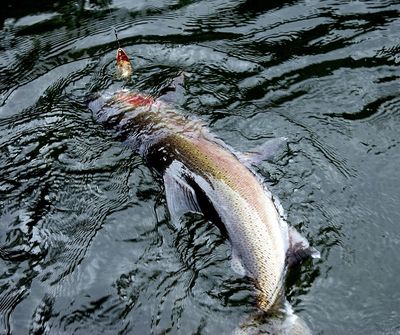Idaho will study wild steelhead

In an effort to get a better picture of how wild steelhead are affected by fishing, the University of Idaho and Idaho Department of Fish and Game will enlist the help of anglers in a two-year study that will track fish as they progress from Lower Granite Dam through the fishery.
Brett Bowersox, a biologist with the Idaho Department of Fish and Game at Lewiston, said external tags will be attached to both wild and hatchery steelhead at the dam. The researchers will then ask anglers who catch tagged fish to either clip the tags off and return them to the department or to record a unique identification number from the tag and report it to researchers.
The steelhead will also be tracked with tiny PIT tags, or passive integrated transponder tags, that are implanted in the body cavity of fish. Tag detectors are positioned at the mouths of streams where wild steelhead spawn, allowing researchers to detect how many of the fish in the study ultimately reach spawning grounds.
The idea is to more accurately measure how many wild steelhead are caught and released during the long fishing season that targets hatchery steelhead and how well they survive such encounters. Wild steelhead in the Snake River are protected as threatened under the Endangered Species Act. The state’s ability to conduct fisheries on hatchery steelhead depends on its ability to ensure wild steelhead aren’t unduly harmed and are able to escape to spawning grounds in tributaries of the Lochsa, Selway and Middle Fork of the Salmon rivers.
“We have wild stocks in our fisheries, and that is a priority for us,” Bowersox said. “We want our fisheries managed in a way that allows wild fish through the fishery and into these special places.”
Anglers are required to release wild steelhead so they can eventually spawn in the wild. The state is allowed to incidentally harm a small percentage of those fish during the fishery under a permit from the National Oceanic and Atmospheric Administration. Last fall, Idaho’s steelhead season was nearly scuttled after conservation groups threatened to sue state fisheries managers because the permit expired. A last-minute agreement saved the season, but questions remain over the degree to which wild steelhead are harmed during the process of being caught and released.
Bowersox said the study that will start this summer was planned even before the controversy.
“This project is not coming about because of (the controversy) this fall. It’s been on our minds for the last year or so,” he said.
Fisheries managers at the department and researchers at the university are still working out details of the study and plan to announce more information in the coming months, including how they want anglers to report tagged fish.